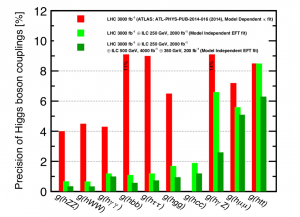
A Higgs factory can determine the exact properties of the particle discovered at the LHC. Illustration: LCC, Ana Kova
The world of particle physics changed in 2012. Following decades of experimental searches and analysis, the scalar particle thought to be responsible for electroweak symmetry breaking, the Higgs boson, was discovered by the ATLAS and CMS experiments at the LHC at CERN. Now that we know of the existence and mass of the Higgs boson, for the first time we also have a clear scale for the minimal energy of the ILC: 250 GeV. Before this discovery, the ILC energy scale was necessarily set higher to ensure the best opportunity for significant physics results. Now that the Higgs mass (125 GeV) is known the ILC can provide a great first-stage physics programme already at 250 GeV. We call this the ILC250.
Today, the LHC continues its programme of measurements of the Higgs boson properties. The LHC has shown the properties are consistent with those of the Standard Model (SM), although the precision of this statement is so far quite limited. There are very good reasons to suspect the Higgs boson discovered at the LHC in 2012 may have properties that deviate slightly from the Higgs boson predicted by the SM. This is because the SM is not capable of explaining a number of critical open questions, such as the identity of the dark matter, the solution to the hierarchy problem, and others. New, beyond-the-Standard-Model (BSM) physics is needed.
Precision studies of the Higgs boson offer one of the best vehicles for discovering the new physics needed to patch the SM. The ILC250 can be viewed as a ‘Higgs Factory,’ with the capability to produce half a million Higgs bosons in a decade with very little background. Through the dominant Higgs production channel, where each Higgs boson is produced in association with a Z boson (e+e- > Zh), we can detect the presence of a Higgs boson by measuring the Z boson, since it is produced with an energy of 110 GeV. Higgs boson events are collected in an unbiased way, including all decay modes, even those outside the SM, such as invisible decays. This technique yields model-independent measurements.
Linear Collider Collaboration colleagues recently sharpened the capability to analyse 250-GeV data (see arXiv:1708.08912, “Improved Formalism for Precision Higgs Coupling Fits”, and arXiv:1710.07621, “Physics Case for the 250 GeV Stage of the International Linear Collider”) this work has advanced our expectations for the precision of the first stage (250 GeV) of the ILC. They developed an improved formalism for extracting the Higgs couplings from the data in electron-positron collisions. Through this formalism, the full spectrum of Higgs boson couplings can be extracted from data with high precision and without assumptions on the physics model.

Figure from K. Fujii, et al., “Physics Case for the 250 GeV Stage of the International Linear Collider,” arXiv:1710.07621.
LHC future plans include continued operations for two decades with increased luminosity and the potential to accumulate 3000 fb-1 with the HL-LHC (the 13 GeV data to date totals about 100 fb-1). With this increase there are many new physics topics that can be addressed. How would this increased data at the HL-LHC contribute to improved precision measurements in the Higgs boson couplings? And how does that improvement compare to the potential of the ILC250? The figure (from arXiv:1710.07621) shows this. Shown in red are the ATLAS model-dependent projections for the 3000 fb-1 precision of Higgs couplings, and the light green shows the model-independent improvement that results from adding the ILC250 data and applying the new formalism. The improvement with ILC250 is dramatic. With this comes the ability to discover BSM effects in the coupling measurements, and to distinguish between many different BSM concepts. This ability is also presented in the physics case paper arXiv:1710.07621, where various new physics models are considered, each unlikely to be discoverable at the LHC. Each model results in its special pattern of Higgs coupling deviations, with the potential to identify the underlying source of SM breaking measurements.
Besides the critical precision measurements of the Higgs boson couplings, the ILC250 also has other important physics opportunities. Some of these are discussed in arXiv:1710.07621. For example, ILC250 has the potential to discover directly produced new particles that escape discovery at the LHC; interesting scenarios will remain for ILC250. Other measurements will include triple-gauge couplings and SM tests through two-fermion channels. The ILC beam polarisations enhance these studies.
A significant advantage for the ILC is its energy upgradability. The 250-GeV collider may be the first stage of the project, with energy expansion coming as physics motivations lead to support for upgrades. We already have excellent arguments for higher energy steps, such as the structure of the top quark, Higgs boson coupling to the top quark, and the Higgs boson’s own self-coupling; energy increases open access to these measurements. 500-GeV operation also improves the ILC250 Higgs boson coupling measurement by about a factor of two, as shown by the dark green bars in the figure. The ILC250 could be the first step on this journey.
The physics case for ILC250 is exceptional and unique. ILC250 technical readiness means construction can begin when funding appears. And an important motivation for the linear collider is the potential for future energy upgrades when the physics calls for it. So, overall, we have an extremely strong, special case for the ILC250. We are prepared and eager to get on with the project as soon as we get approval.


Recent Comments